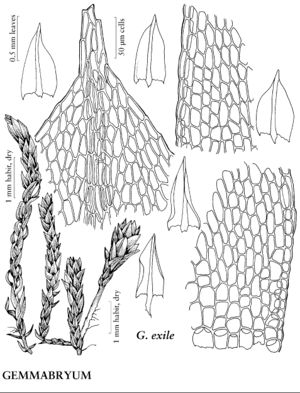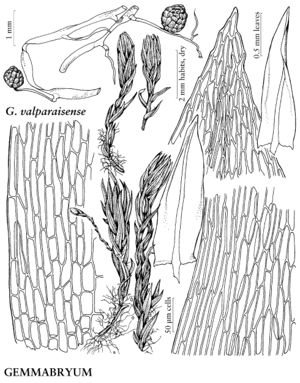Gemmabryum
Phytologia 87: 63. 2005.
| Taxon | Illustrator ⠉ | |
|---|---|---|
 | Gemmabryum exile | Patricia M. Eckel |
 | Gemmabryum valparaisense | Patricia M. Eckel |
Plants small to large, in open to dense turfs or gregarious, green, yellow-green, pink, or red. Stems 0.1–2 (–3) cm, gemmiform to evenly foliate, not or strongly branched; rhizoids usually few, micronemata present, macronemata few or absent. Leaves imbricate to loosely set and slightly twisted when dry, spreading when moist, ovate, ovatelanceolate, or triangular, flat or concave, 0.4–2.5 (–3) mm; base rarely decurrent; margins plane to strongly revolute, entire to serrulate distally, 1-stratose, limbidium absent or weak; apex broadly rounded to acuminate; costa not reaching apex to long-excurrent, awn present, apiculus occasionally present, guide cells usually in 1 layer; alar cells quadrate; laminal areolation heterogeneous; proximal laminal cells gradually or abruptly quadrate to rectangular, shorter than more distal cells, 1–2 (–4):1; medial and distal cells rhomboidal to elongate-hexagonal, 8–16 (–20) µm wide, usually (3–) 4–8: 1, walls thin to moderately incrassate, not porose. Specialized asexual reproduction common, of several types, including leaf-axil bulbils or brood branchlets, rhizoidal filiform gemmae and tubers, and stem tubers. Sexual condition dioicous or rarely synoicous; perigonia and perichaetia terminal; perigonial and perichaetial leaves not much differentiated, outer leaves larger, inner leaves smaller than leaves of innovations. Seta usually single, straight or somewhat flexuose, not geniculate. Capsule erect, inclined, or nutant, pyriform or ovate, not zygomorphic, 1–3 (–5) mm; hypophysis slender or thick, sometimes inflated and rugose; operculum short-conic to long-convex, sometimes apiculate or rarely rostrate; peristome double; exostome yellow to brown, teeth lanceolate, acuminate; endostome rarely adherent to exostome, basal membrane high to low, segments well developed or occasionally reduced, perforations lanceolate to ovate, cilia long and appendiculate to short or absent. Spores shed singly, 8–18 (–20) µm, smooth to papillose, light-brown.
Distribution
Nearly worldwide, tropical, subtropical, temperate to boreal regions
Discussion
Species ca. 100 (19 in the flora).
Species of Gemmabryum are small and often sterile, and can be extremely difficult to identify in the absence of gemmae. This genus exhibits a remarkable array of asexual reproductive structures, including bulbils, rhizoidal tubers, stem tubers, and filiform rhizoidal gemmae. Sterile collections should be made whenever possible, as fertile material often lacks the diagnostic gemmae.
Selected References
None.
Lower Taxa
Key
| 1 | Specialized asexual reproduction by leaf axil bulbils or brood branchlets, rarely by rhizoidal tubers; stems gemmiform or evenly foliate, often in 2 or more clumps along stem; leaves imbricate | > 2 |
| 1 | Specialized asexual reproduction by rhizoidal tubers; stems evenly foliate; leaves imbricate to loosely set, usually slightly twisted when dry | > 3 |
| 2 | Bulbils absent; costae usually long-excurrent; inflated group of pinkish subalar cells present; leaf axil brood branchlets sometimes present; limbidium often present. | Gemmabryum sect. Caespitibryum |
| 2 | Bulbils present or absent; costae percurrent to short-excurrent; inflated group of pinkish subalar cells absent; brood branchlets absent; limbidium absent. | Gemmabryum sect. Gemmabryum |
| 3 | Plants pale green to red-green; stems gemmiform to evenly foliate, often in 2 or more clumps along stem; leaf costae long-excurrent; inflated group of pinkish subalar cells often present; brood branchlets sometimes present; limbidium often present. | Gemmabryum sect. Caespitibryum |
| 3 | Plants green or yellow-green, often with pinkish or reddish tinge; stems evenly foliate; leaf costae percurrent to short-excurrent, if long-excurrent then rhizoidal tubers common; inflated group of pinkish subalar cells absent; brood branchlets absent; limbidium usually absent. | Gemmabryum sect. Tuberibryum |
"narrower" is not a number."narrow" is not a number.